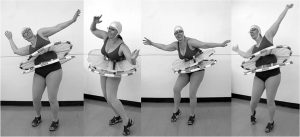Source: Danielle Wilde. 2012. hipDisk: understanding the value of ungainly, embodied, performative, fun. In CHI ’12 Extended Abstracts on Human Factors in Computing Systems (CHI EA ’12). ACM, New York, NY, USA, 111-120. DOI: http://dx.doi.org/10.1145/2212776.2212789
Summary: The hipDisk is a device to be worn on the waist. It consists of two disks that do not touch each other, and extend the wearer’s hips horizontally. If the disks touch each other an electronic circuit gets closed, tones are triggered, and played through the integrated speakers. Soft switches are placed around the outer line of the disks, and the wearer needs to make strange movements with his/her torso causing the two disks to touch, and actuate sound. The creator’s idea was to give the moving body musical capabilities while doing unusual bends and twists with one’s hips. This opens new ways of moving to people, and extends perceiption as well from a user’s as from an observers perspective. The attention is shift to a new way of expressiveness, using it makes fun, and extends the wearer’s motor skills. Whereas from an observer’s perspective engagement increases because everyone wearing the hipDisk looks clumsy and silly, there is no way of delicate movements, but wearers seem to have fun, what makes one curious from the outside view to have the same uncommon experiences.

Relevance for our project: The hipDisks are an innovative wearable interface sensing uncommon movements of the human body – this can be inspiring for us to find our own ideas, and define an interaction scenario for on-stage performances. On the other hand, this device combines sensor (soft switches) and actuators (speakers) both at the same time, but we are to create a wearable that senses bodily data from its wearer, and reflects them through its environment. That means the signals gathered through the switches should have been transmitted wirelessly to an external music system for fullfilling our requirements. Further, the hipDisks can be worn by everyone, and we aim to create an application for performers (e.g. dancer or actors), but since the movements caused by the hipDisks are very uncommon and entertaining we guess they offer great on-stage capabilities.
